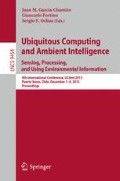Abstract
Activity Recognition in a scientific setting is a field that is extremely popular, in which numerous and diverse proposals exist that tackle the creation of systems capable of recognising activities through different types of sensors. Given the relative maturity of Activity Recognition in comparison to Behaviour Recognition, most of the existing proposals in this last field are based in Activity Recognition but with the difference of analysing the activities throughout time. Therefore, the objective of this article is to describe the first phases of development of a larger scale research (doctoral thesis) with which we will intend to analyse the Behaviour of people with focus not only based on Activity Recognition but also with a strong component centered around smart environments with context awareness and supported by the foundations of The Psychology of behaviour.
Access this chapter
Tax calculation will be finalised at checkout
Purchases are for personal use only
References
Alexiadis, D.S., Kelly, P., Daras, P., O’Connor, N.E., Boubekeur, T., Moussa, M.B.: Evaluating a dancer’s performance using kinect-based skeleton tracking. In: Proceedings of the 19th ACM International Conference on Multimedia, pp. 659–662. ACM, Scottsdale (2011)
Bansal, S., Khandelwal, S., Gupta, S., Goyal, D.: Kitchen activity recognition based on scene context. In: International Conference on Image Processing (ICIP), pp. 3461–3465. IEEE, Melbourne (2013)
Biswas, K.K., Basu, S.K.: Gesture recognition using Microsoft Kinect®. In: Automation, Robotics and Applications (ICARA) 5th International Conference, pp. 100–103. IEEE, Wellington (2011)
Boger, J., Hoey, J., Poupart, P., Boutilier, C., Fernie, G., Mihailidis, A.: A planning system based on Markov decision processes to guide people with dementia through activities of daily living. IEEE Trans. Inf. Technol. Biomed. 10(2), 323–333 (2006)
Brush, A., Krumm, J., Scott, J.: Activity recognition research: the good, the bad, and the future. In: Pervasive Workshop How to do Good Research in Activity Recognition, Helsinki, Finland (2010)
Dey, A.K.: Understanding and using context. Pers. Ubiquit. Comput. 5(1), 4–7 (2001)
Fontecha, J., Navarro, F.J., Hervás, R., Bravo, J.: Elderly frailty detection by using accelerometer-enabled smartphones and clinical information records. Pers. Ubiquit. Comput. 17(6), 1073–1083 (2013)
Fu, J., Liu, C., Hsu, Y.P., Fu, L.C.: Recognizing context-aware activities of daily living using RGBD sensor. In: IEEE/RSJ International Conference on Intelligent Robots and Systems (IROS), pp. 2222–2227. IEEE, Tokyo (2013)
Goncalves, N., Costa, S., Rodrigues, J., Soares, F.: Detection of stereotyped hand flapping movements in Autistic children using the Kinect sensor: a case study. In: Autonomous Robot Systems and Competitions (ICARSC), pp. 212–216. IEEE, Espinho (2014)
Hervas, R., Bravo, J., Fontecha, J.: An assistive navigation system based on augmented reality and context awareness for people with mild cognitive impairments. IEEE J. Biomed. Health Inform. 18(1), 368–374 (2014)
Ladha, C., Hammerla, N., Hughes, E., Olivier, P., Plötz, T.: Dog’s life: wearable activity recognition for dogs. In: Proceedings of the ACM International Joint Conference on Pervasive and Ubiquitous Computing, pp. 415–418. ACM, Zurich (2013)
Leightley, D., Darby, J., Li, B., McPhee, J.S., Yap, M.H.: Human activity recognition for physical rehabilitation. In: IEEE International Conference on Systems, Man, and Cybernetics (SMC), pp. 261–266. IEEE, Manchester (2013)
Ramirez-Giraldo, D., Molina-Giraldo, S., Alvarez-Meza, A.M., Daza-Santacoloma, G., Castellanos-Dominguez, G.: Kernel based hand gesture recognition using kinect sensor. In: XVII Symposium on Image, Signal Processing, and Artificial Vision (STSIVA), pp. 158–161. IEEE, Antioquia (2012)
Raso, I., Hervás, R., Bravo, J.: m-Physio: personalized accelerometer-based physical rehabilitation platform. In: Proceedings of the Fourth International Conference on Mobile Ubiquitous Computing, Systems, Services and Technologies, pp 416–421, Florence, Italy (2010)
Ryoo, M.S., Matthies, L.: First-person activity recognition: what are they doing to me? In: Computer Vision and Pattern Recognition (CVPR), pp. 2730–2737. IEEE, Portland, (2013)
Tapia, E.M., Intille, S.S., Larson, K.: Activity recognition in the home using simple and ubiquitous sensors. In: Ferscha, A., Mattern, F. (eds.) Pervasive Computing. LNCS, vol. 3001, pp. 158–175. Springer, Berlin Heidelberg (2004)
Veltmaat, M.J.T., van Otterlo, M., Vogt, J.: Recognizing activities with the Kinect. Technical report, Radboud University Nijmagen (2013)
Yang, Z., Zicheng, L., Hong, C.: RGB-depth feature for 3D human activity recognition. Commun. Chin. 10(7), 93–103 (2013)
Acknowledgments
This work was conducted in the context of UBIHEALTH project under International Research Staff Exchange Schema (MC-IRSES 316337) and the coordinated project grant TIN2013-47152-C3-1-R (FRASE), funded by the Spanish Ministerio de Ciencia e Innovación.
Author information
Authors and Affiliations
Corresponding author
Editor information
Editors and Affiliations
Rights and permissions
Copyright information
© 2015 Springer International Publishing Switzerland
About this paper
Cite this paper
Gutiérrez López de la Franca, C., Hervás, R., Bravo, J. (2015). Activity Recognition in Intelligent Assistive Environments Through Video Analysis with Body-Angles Algorithm. In: García-Chamizo, J., Fortino, G., Ochoa, S. (eds) Ubiquitous Computing and Ambient Intelligence. Sensing, Processing, and Using Environmental Information. UCAmI 2015. Lecture Notes in Computer Science(), vol 9454. Springer, Cham. https://doi.org/10.1007/978-3-319-26401-1_16
Download citation
DOI: https://doi.org/10.1007/978-3-319-26401-1_16
Published:
Publisher Name: Springer, Cham
Print ISBN: 978-3-319-26400-4
Online ISBN: 978-3-319-26401-1
eBook Packages: Computer ScienceComputer Science (R0)

